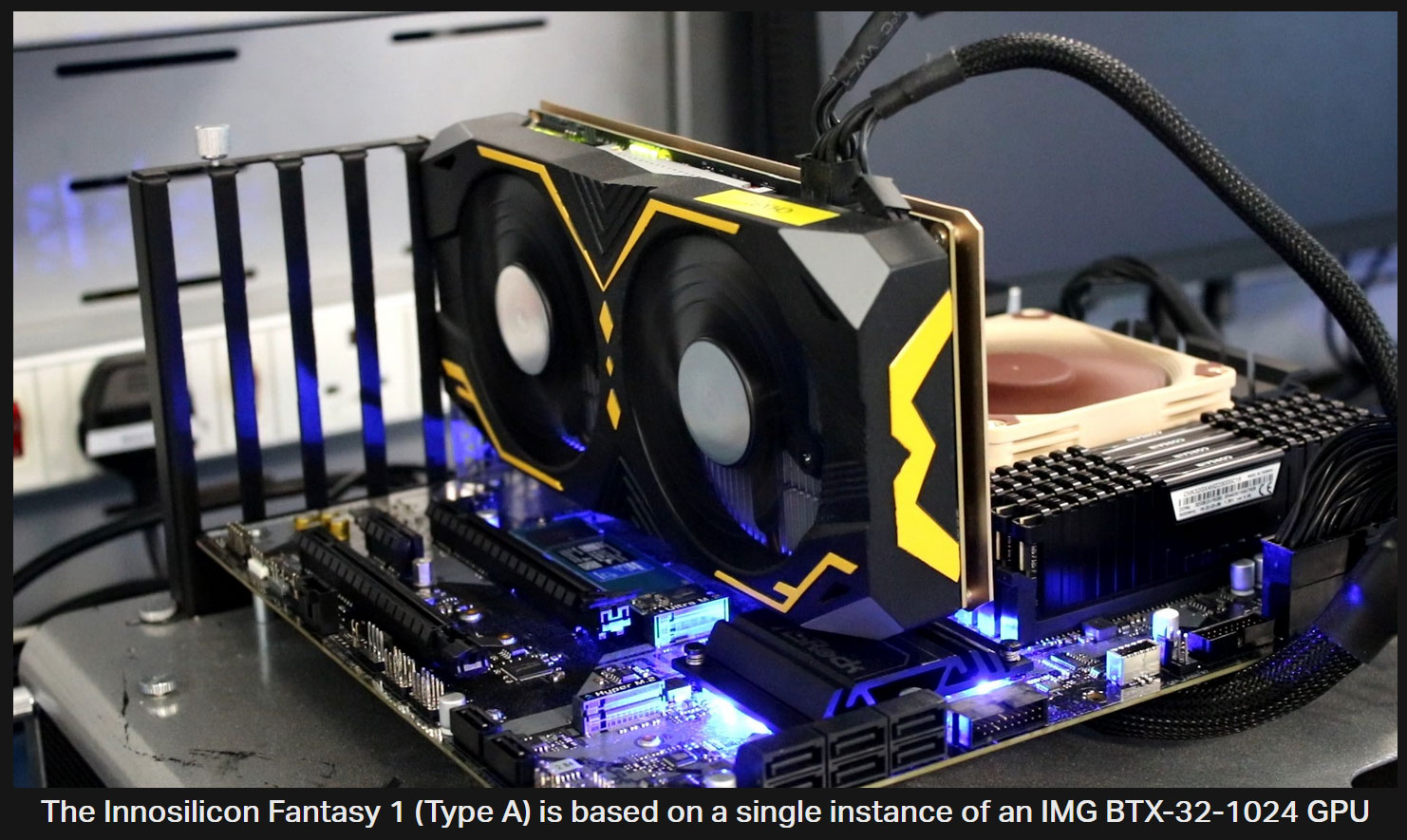Imagination Tech Discusses Its Return to the High-Performance PC GPU Market
Shares image of Innosilicon Fantasy 1 (Type A) with IMG BTX-32-1024 GPU.
Imagination Technologies was one of the earliest developers of dedicated 3D accelerators for PCs. On Tuesday, it confirmed that its BXT-32-1024 GPU has been licensed by China’s Innosilicon to create the Fantasy (Fenghua) 1 Type-A graphics card. This graphics card also sports 16GB of GDDR6X on a 128-bit interface and hits 5 TFLOPS of compute. In addition, a Type-B card is also in production, with a dual-GPU PCB offering up to twice the performance, says ImgTec.
On Tuesday, UK-based ImgTec celebrated the 30th anniversary of PowerVR, the graphics architecture behind legendary GPUs like the Apocalypse 3D/X series. In addition, imagination announced it would get back into the high-performance PC GPU game back in 2020. Still, we hadn’t heard anything very solid about developments or board partners over the last couple of years. Löschzwerg, who spotted this ImgTec blog, says that Fantasy 1 card in the picture is installed on an ASRock Z690 PRO RS motherboard.
In its 30th anniversary blog, ImgTec has confirmed our suspicions about the Fantasy series. This is quite important, as Innosilicon wasn't upfront about the GPU architecture behind its Fantasy series earlier in the year. Innosilicon appeared to indicate to Chinese media that the Fenghua graphics cards were wholly "domestic desktop GPUs."
For some hints at how well these desktop graphics cards might perform, we have reports from this earlier in the year that hint that the Fantasy 1 Type A will target GeForce RTX 3060 grade performance. Moreover, we hear that the GPU has been built on the 12nm process in China and includes HDMI 2.1, DP 1.4, and VGA outputs with multiple monitor support.
The 'double power' Fantasy 1 Type B card was supposed to officially launch in August. However, we're still waiting for some solid details and benchmarking of cards like the Fantasy 1 Type A, which launched about nine months ago.
We will keep our eyes open for some more insights into PowerVR's rebirth in China, hoping for a wider geographic spread. Meanwhile, PC graphics continues to be dominated by Nvidia and AMD, who are both queuing up exciting upgrades for the latter portion of this year. Also, we can't forget Intel, which has some decent-looking mid-range firepower lined up for later in the year in the form of its Arc A750 and A770. First, however, we shall have to see whether they can edge into our hotly contested best graphics cards list.
Get Tom's Hardware's best news and in-depth reviews, straight to your inbox.

Mark Tyson is a news editor at Tom's Hardware. He enjoys covering the full breadth of PC tech; from business and semiconductor design to products approaching the edge of reason.
-
-Fran- You know. As of late I'm starting to think no new GPU company that wants to enter the market needs the absolute top dog and instead they just need to satisfy the (under) <$300 segment in full and they'll sell a TON. AMD and nVidia just don't give a rat's behind anymore and they left a huge hole* many companies can just fill with decent enough offerings. Imagination, Qualcomm and even Matrox can somehow fit that market I'd say. Intel is trying, yes, but they're just the laughing stock for now.Reply
Regards. -
Gam3r01 Reply
Id agree with that notion.-Fran- said:You know. As of late I'm starting to think no new GPU company that wants to enter the market needs the absolute top dog and instead they just need to satisfy the (under) <$300 segment in full and they'll sell a TON. AMD and nVidia just don't give a rat's behind anymore and they left a huge hole* many companies can just fill with decent enough offerings. Imagination, Qualcomm and even Matrox can somehow fit that market I'd say. Intel is trying, yes, but they're just the laughing stock for now.
Regards.
Trying to take on AMD or Nvidia in the mid-high end markets would be a mistake to say the least.
But, if they could provide entry level-1080p gaming cards at a reasonable price, they would move substantial volumes.
The problem comes with trust though, everyone knows who AMD and Nvidia are, a new company would have to really impress to get their foot in the door. I could see them causing the other brands to intro cards at similar price/performance ratio effectively forcing them out of market though. -
Nikolay Mihaylov It would have been awesome if they showed up with a working product one year ago. Now - not so much. Sure, there's a conspicuous pricing hole at the low end but I wonder how low the price can be in the current situation (supply problems + rising prices) without being slower than an iGPU. I would rather suggest that the second hand market would replace the low end new GPU market.Reply -
renz496 Reply-Fran- said:You know. As of late I'm starting to think no new GPU company that wants to enter the market needs the absolute top dog and instead they just need to satisfy the (under) <$300 segment in full and they'll sell a TON. AMD and nVidia just don't give a rat's behind anymore and they left a huge hole* many companies can just fill with decent enough offerings. Imagination, Qualcomm and even Matrox can somehow fit that market I'd say. Intel is trying, yes, but they're just the laughing stock for now.
Regards.
sub $300 segment? problem is they might not making money at all at that segment. when AMD launch RX5600XT Sapphire told TPU that just to make the card within MSRP is almost impossible. also consumer/gaming GPU revenue is not big. nvidia own 80% of discrete GPU sales and recently with declining mining demand the revenue is just 2 billion. this alone makes many of legit GPU maker that still exist did not want to enter pc discrete market. also Imagination, Qualcomm and Matrox have their own set of issues. -
peachpuff Reply
Intel: hello 👋-Fran- said:You know. As of late I'm starting to think no new GPU company that wants to enter the market needs the absolute top dog and instead they just need to satisfy the (under) <$300 segment in full and they'll sell a TON. -
Giroro I bet the Chinese government is extremely happy that a western company was dumb enough to 'license' their GPU tech to a Chinese company.Reply
Now the CCP will have unlimited free access to redistribute access to this "wholly domestic" design, to any of their other companies, forever. Welcome to Communism, ImgTec must be new here. -
TesseractOrion Reply
Yawn. Here's the anti-China troll, as expected. Complaining about a legitimate licensing deal, which all companies everywhere do all the time.Giroro said:I bet the Chinese government is extremely happy that a western company was dumb enough to 'license' their GPU tech to a Chinese company.
Now the CCP will have unlimited free access to redistribute access to this "wholly domestic" design, to any of their other companies, forever. Welcome to Communism, ImgTec must be new here.
But because it goes against your 'Murica first worldview , it's gotta be evil commies spying on you LOL -
bit_user Reply
Imagination Technologies is owned by a Chinese private equity firm. There were rumors of a power struggle on the board, with appeals for the UK government to intervene, as terms of the sale agreement (involving IP-transfer, I think) under which the UK permitted the acquisition were allegedly being violated. I haven't followed too closely, but if you like that sort of intrigue, you should read up on it.Giroro said:I bet the Chinese government is extremely happy that a western company was dumb enough to 'license' their GPU tech to a Chinese company.
I still blame Apple for being too cheap to just buy Imagination, outright. I don't know what happened, but my guess is that Imagination overplayed its hand and Apple didn't like being strong-armed to overpay for a key supplier. That would set a bad precedent for their other suppliers.
BTW, AMD and Nvidia have been doing some design work in China for like 15 years now. I think there's at least one entirely homegrown Chinese GPU and there will probably be more. The Chinese don't really need tech from Imagination to become competitive in this market. They would get there, either way. -
bit_user Reply
From what I've heard, Imagination has an absolutely horrible reputation for its drivers.Gam3r01 said:The problem comes with trust though, everyone knows who AMD and Nvidia are, a new company would have to really impress to get their foot in the door.
They recently started open sourcing their Linux driver stack, earlier this year. That might help with Linux, but I'm not sure about the state of their Windows drivers.
I think the reason for their open source moves is that they've gotten into the RISC-V game and are trying to follow ARM's model becoming a one-stop-shop for all the IP blocks needed to make a complete SoC. And maybe they figured that open sourcing their drivers would give them an edge in that market vs. ARM. Right now, they need all the edges they can get!
